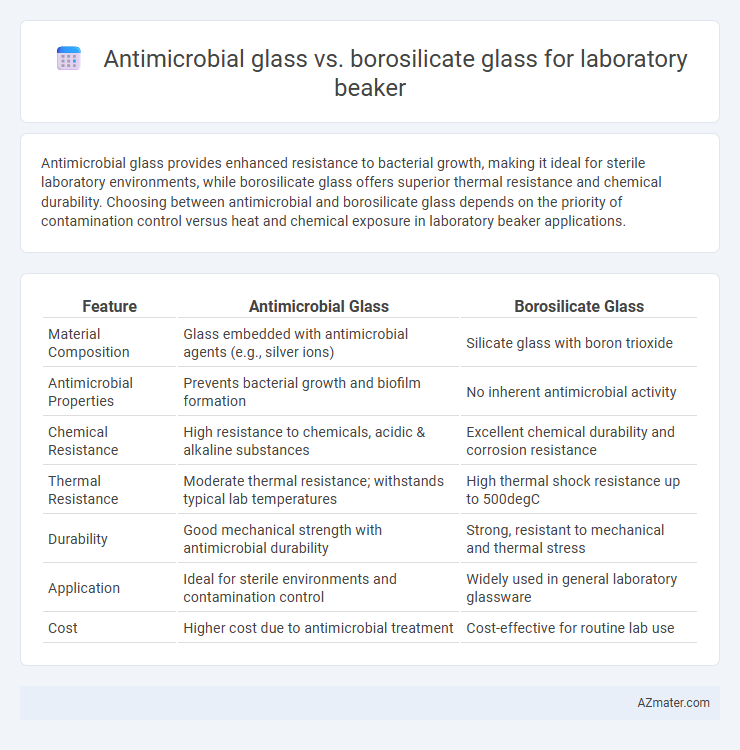Antimicrobial glass provides enhanced resistance to bacterial growth, making it ideal for sterile laboratory environments, while borosilicate glass offers superior thermal resistance and chemical durability. Choosing between antimicrobial and borosilicate glass depends on the priority of contamination control versus heat and chemical exposure in laboratory beaker applications.
Table of Comparison
| Feature | Antimicrobial Glass | Borosilicate Glass |
|---|---|---|
| Material Composition | Glass embedded with antimicrobial agents (e.g., silver ions) | Silicate glass with boron trioxide |
| Antimicrobial Properties | Prevents bacterial growth and biofilm formation | No inherent antimicrobial activity |
| Chemical Resistance | High resistance to chemicals, acidic & alkaline substances | Excellent chemical durability and corrosion resistance |
| Thermal Resistance | Moderate thermal resistance; withstands typical lab temperatures | High thermal shock resistance up to 500degC |
| Durability | Good mechanical strength with antimicrobial durability | Strong, resistant to mechanical and thermal stress |
| Application | Ideal for sterile environments and contamination control | Widely used in general laboratory glassware |
| Cost | Higher cost due to antimicrobial treatment | Cost-effective for routine lab use |
Introduction to Laboratory Glassware Materials
Antimicrobial glass incorporates ion-releasing agents, such as silver or copper ions, to inhibit microbial growth on surfaces, making it ideal for sterile laboratory environments. Borosilicate glass, known for its high thermal resistance, chemical durability, and low thermal expansion, is widely used in laboratory beakers for its ability to withstand temperature fluctuations and chemical corrosion. Selecting between antimicrobial glass and borosilicate glass depends on balancing microbial control needs with thermal and chemical resistance requirements in laboratory settings.
Understanding Antimicrobial Glass: Composition and Properties
Antimicrobial glass, often embedded with silver ions or copper nanoparticles, inhibits microbial growth on its surface, making it highly suitable for laboratory beakers requiring sterility. This glass type combines the durability and thermal resistance of traditional borosilicate glass with enhanced antimicrobial properties that reduce contamination risks. Unlike standard borosilicate glass, antimicrobial glass maintains chemical stability while providing an active defense against bacteria and fungi.
What is Borosilicate Glass? Key Features
Borosilicate glass is a type of laboratory glass known for its exceptional thermal resistance and chemical durability, making it ideal for beakers that undergo rapid temperature changes and exposure to corrosive substances. Key features include low thermal expansion, high resistance to thermal shock, and excellent mechanical strength, ensuring durability in demanding laboratory environments. Compared to antimicrobial glass, borosilicate glass prioritizes structural integrity and resistance rather than inherent antimicrobial properties.
Chemical Resistance: Antimicrobial vs Borosilicate Glass
Antimicrobial glass incorporates biocidal agents that inhibit microbial growth without compromising its chemical resistance, making it suitable for sterile laboratory environments. Borosilicate glass is renowned for its exceptional chemical resistance against acids, bases, and solvents, maintaining structural integrity under harsh laboratory conditions. While both glasses offer robust chemical resistance, borosilicate glass remains the standard for chemical durability, whereas antimicrobial glass provides additional benefits in microbial control.
Sterility and Contamination Control in Laboratory Settings
Antimicrobial glass offers enhanced sterility by incorporating antimicrobial agents that inhibit bacterial growth and biofilm formation on laboratory beakers, significantly reducing contamination risks during experiments. Borosilicate glass, known for its chemical resistance and thermal stability, lacks inherent antimicrobial properties, requiring rigorous cleaning protocols to maintain sterility. Choosing antimicrobial glass facilitates improved contamination control in laboratory settings by minimizing microbial proliferation on surfaces, essential for maintaining experimental integrity and safety.
Mechanical Strength and Durability Comparison
Antimicrobial glass for laboratory beakers integrates silver ions or other antimicrobial agents into the glass matrix, enhancing its resistance to microbial growth without compromising mechanical strength. Borosilicate glass, known for its thermal shock resistance and high mechanical durability, exhibits excellent impact strength and can withstand rapid temperature changes, making it a preferred choice for many laboratory applications. When comparing mechanical strength and durability, borosilicate glass generally offers superior structural resilience under thermal and mechanical stress, while antimicrobial glass provides added hygiene benefits with comparable durability for routine lab use.
Thermal Stability: Performance Under Extreme Temperatures
Antimicrobial glass exhibits enhanced resistance to microbial contamination but may have limited thermal stability compared to borosilicate glass, which is renowned for its exceptional performance under extreme temperatures ranging from -70degC to 500degC. Borosilicate glass maintains structural integrity and resists thermal shock, making it ideal for rapid temperature changes in laboratory beakers. Thermal stability of borosilicate glass outperforms most antimicrobial coatings, ensuring consistent performance in high-heat applications.
Cost Analysis: Antimicrobial Glass vs Borosilicate Glass
Antimicrobial glass for laboratory beakers typically incurs higher initial costs due to advanced surface treatments and embedded antimicrobial agents, which can range from 20% to 40% more compared to standard borosilicate glass. Borosilicate glass offers cost efficiency with lower upfront prices and widespread availability, making it a preferred choice for budget-conscious laboratories. Over time, antimicrobial glass may reduce expenses related to contamination and cleaning, potentially offsetting higher purchase costs in high-sterility applications.
Applications and Suitability in Laboratory Procedures
Antimicrobial glass offers enhanced protection against microbial contamination, making it highly suitable for sterile laboratory environments and procedures requiring reduced risk of sample contamination. Borosilicate glass provides excellent thermal resistance and chemical durability, ideal for high-temperature experiments and handling corrosive reagents. Both materials serve distinct applications, with antimicrobial glass favored in microbiology and cell culture, while borosilicate glass is preferred for general chemical and thermal laboratory tasks.
Choosing the Right Glassware: Factors to Consider
When choosing between antimicrobial glass and borosilicate glass for laboratory beakers, consider factors such as chemical resistance, durability, and sterilization needs. Antimicrobial glass offers enhanced protection against bacterial contamination, making it ideal for microbiology and medical labs, while borosilicate glass excels in thermal shock resistance and chemical inertness, suitable for high-temperature and reactive experiments. Prioritize the specific laboratory application, exposure conditions, and hygiene requirements to select the most appropriate glass material.

Infographic: Antimicrobial glass vs Borosilicate glass for Laboratory beaker
 azmater.com
azmater.com